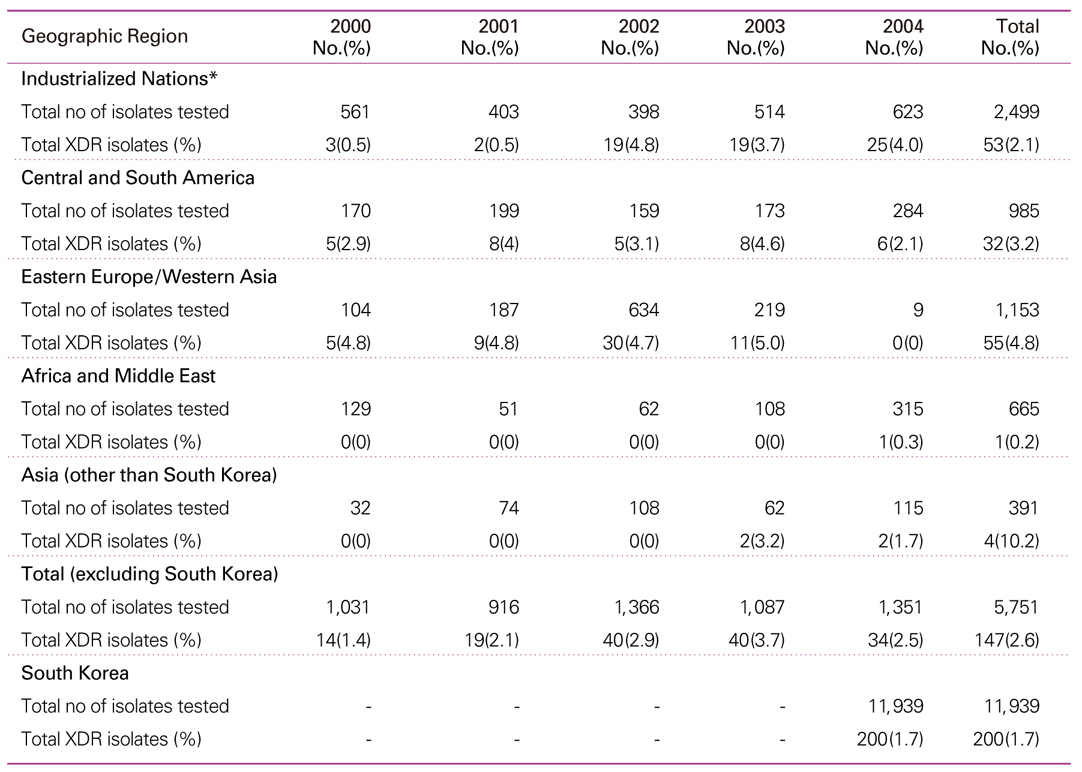 |
 |
- Search
| J Korean Med Assoc > Volume 51(2); 2008 > Article |
Abstract
Multidrug-resistant tuberculosis(MDR-TB), resistant to at least the two main TB drugsisoniazid and rifampicin, has been a threat to TB control because the treatment requires more toxic drugs and longer period with poor treatment outcomes. Recently, more serious concerns have been raised about extensively drug resistant-tuberculosis (XDR-TB), which shows resistance to fluoroquinolones and aminoglycosides in addition to isoniazid and rifampicin. XDR-TB is a serious global health threat because the cure is very difficult as few sensitive anti-TB drugs remain. XDR-TB develops when first-and second-line anti-TB drugs are misused during the course of treatment, most commonly due to poor compliance of the patients to the treatment regimen. People with XDR-TB can pass the XDR-TB bacteria to other people. Thus, every effort should be made to prevent the development of XDR-TB by establishing an effective TB control program maximizing patient adherence to prescribed anti-TB regimen and minimizing contact of XDR-TB patients with other people to prevent the spread of XDR-TB.
References
1. Sharma SK, Mohan A. Multidrug-resistant tuberculosis: a menace that threatens to destabilize tuberculosis control. Chest 2006;130:261-262.
2. Centers for Disease Control and Prevention. Revised definition of extensively drug-resistant tuberculosis. MMWR 2006;55:1176.
3. Pillay M, Sturm AW. Evolution of the extensively drug-resistant F15/LAM4/KZN strain of Mycobacterium tuberculosis in KwaZulu-Natal, South Africa. Clin Infect Dis 2007;45:1409-1414.
4. Helen SC, Stobdan K, Sholpan A, Vinciane S, Zinaida NT, Sabine RG, Hamraev AK, Yared K, Clair M. Multidrug-resistant tuberculosis treatment outcomes in Karakalpakstan Uzbekistan: Treatment complexity and XDR-TB among treatment failure. PLos One 2007;2:e1126.
5. Centers for Disease Control and Prevention. Extensively drug-resistant tuberculosis-United States, 1993-2006. MMWR 2007;56:250-253.
6. Centers for Disease Control and Prevention. Emergence of Mycobacterium tuberculosis with extensive resistance to second-line drugs-worldwide, 2000-2004. MMWR 2006;55:301-305.
7. Gandhi NR, Moll A, Sturm AW, Pawinski R, Govender T, Lalloo U, Zeller K, Andrews J, Frienland G. Extensively drug resistant tuberculosis as a cause of death in patients co-infected with tuberculosis and HIV in a rural area of South Africa. Lancet 2006;368:1575-1580.
8. Singh S, Sankar MM, Gopinath K. High rate of extensively drug-resistant tuberculosis in Indian AIDS patients. AIDS 2007;21:2345-2347.
9. Kim HR, Hwang SS, Kim HJ, Lee SM, Yoo CG, Kim YW, Han SK, Shim YS, Yim JJ. Impact of extensive drug resistance on treatment outcomes in non-HIV-infected patients with multidrug resistant tuberculosis. Clin Infect Dis 2007;45:1290-1295.
10. Lee JY, Choi HJ, Lee HY, Joung EY, Huh JW, Oh YM, Lee SD, Kim DS, Kim WD, Shim TS. Recovery rate and characteristics of nontuberculous mycobacterial isolates in a university hospital in Korea. Tuber Respir Dis 2005;58:385-391.
11. Shandil RK, Jayaram R, Kaur P, Gaonkar S, Suresh BL, Mahesh BN, Javashree R, Nandi V, Bharath S, Balasubramanian V. Moxifloxacin, ofloxacin, sparfloxacin, and ciprofloxacin against Mycobacterium tuberculosis: evaluation of in vitro and pharmacodynamic indices that best predict in vivo efficacy. Antimicrob Agents Chemother 2007;51:576-582.
12. Fortun J, Martin-Davila P, Navas E, Perez-Elias MJ, Cobo J, Tato M, De la Pedrosa EG, Gomez-Mampaso E, Moreno S. Linezolid for the treatment of multidrug-resistant tuberculosis. J Antimicrob Cehmother 2005;56:180-185.
13. Rubinstein E, Isturiz R, Standiford HC, Smith LG, Oliphant TH, Cammarata S, Hafkin B, Le V, Remington J. Worldwide assessment of linezolid's clinical safety and tolerability: comparator-controlled phase III studies. Antimicrob Agents Chemother 2003;47:1824-1831.
14. O'Brien RJ, Nunn PP. The need for new drugs against tuberculosis: obstacles, opportunities, and next steps. Am J Respir Crit Care Med 2001;162:1055-1058.
15. Spigelman M, Gillespie S. Tuberculosis drug development pipeline: progress and hope. Lancet 2006;367:945-947.
16. Matteelli A, Migliori GB, Cirillo D, Centis R, Girard E, Raviglilon M. Multidrug-resistant and extensively drug-resistant Mycobacterium tuberculosis: epidemiology and control. Expert Rev Anti Infect Ther 2007;5:857-871.
17. Kim HJ. Current situation of tuberculosis and its control in Korea. J Korean Med Assoc 2006;49:762-772.
- TOOLS
-
METRICS

-
- 0 Crossref
- Scopus
- 1,262 View
- 7 Download
-
Related articles in
J Korean Med Assoc






